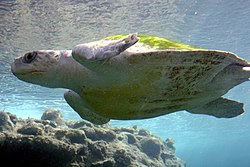
Podocnemididae is a family of pleurodire (side-necked) turtles native to Madagascar and northern South America, though they were more widely distributed in the past. Podocnemidid turtles are commonly called "side-necked turtles" in direct reference to their inability to retract their heads backwards, but hide them sideways. In addition, their pelvis is fused to the shell which prevents any pelvic motion. Due to their pelvis being immobile they are unable to walk on land, which requires greater pelvis mobility. For this reason, Podocnemididae turtles are best suited for swimming and as a result live in aquatic environments. These turtles are all aquatic, inhabiting streams and other flowing water. Their shells are streamlined to aid in swimming.

The Messel Pit is a disused quarry near the village of Messel about 35 km (22 mi) southeast of Frankfurt am Main, Germany. Bituminous shale was mined there. Because of its abundance of fossils, it has significant geological and scientific importance. After almost becoming a landfill, strong local resistance eventually stopped these plans and the Messel Pit was declared a UNESCO World Heritage site on 9 December 1995. Significant scientific discoveries are still being made and the site has increasingly become a tourist site as well.

Chelodina, collectively known as snake-necked turtles, is a large and diverse genus of long-necked chelid turtles with a complicated nomenclatural history. Although in the past, Macrochelodina and Macrodiremys have been considered separate genera and prior to that all the same, they are now considered subgenera of the Chelodina, further Macrochelodina and Macrodiremys are now known to apply to the same species, hence Chelydera is used for the northern snake-necked turtles.

Meiolaniidae is an extinct family of large, possibly herbivorous stem group-turtles with heavily armored heads and tails known from South America and Australasia. Though once believed to be cryptodires, they are not closely related to any living species of turtle, and lie outside crown group Testudines, having diverged from them around the Middle Jurassic. They are best known from the last surviving genus, Meiolania, which lived in the rain forests of Australia from the Miocene until the Pleistocene, and insular species that lived on Lord Howe Island and New Caledonia during the Pleistocene and possibly the Holocene for the latter.
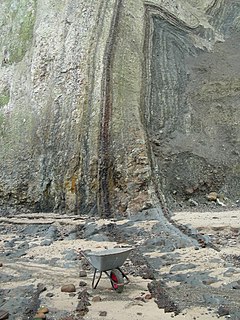
The Fur Formation is a marine geological formation of Ypresian age which crops out in the Limfjord region of Denmark from Silstrup via Mors and Fur to Ertebølle, and can be seen in many cliffs and quarries in the area. The Diatomite Cliffs is on the Danish list of tentative candidates for World Heritage and may become a world Heritage site.

Bothremydidae is an extinct family of side-necked turtles (Pleurodira) known from the Cretaceous and Cenozoic. They are closely related to Podocnemididae, and are amongst the most widely distributed pleurodire groups, with their fossils having been found in Africa, India, the Middle East, Europe, North America and South America. Bothremydids were aquatic turtles with a high morphological diversity, indicative of generalist, molluscivorous, and piscivorous diets. Unlike modern pleurodires, which are exclusively freshwater, bothremydids inhabited freshwater, marine and coastal settings. Their marine habits allowed bothremydids to disperse across oceanic barriers into Europe and North America during the early Late Cretaceous (Cenomanian). The youngest records of the group are indeterminate remains from Saudi Arabia and Oman, dating to the Miocene.

Psephophorus is an extinct genus of sea turtle that lived from the Oligocene to the Pliocene. Its remains have been found in Europe, Africa, North America, and New Zealand. It was first named by Hermann von Meyer in 1847, and contains seven species, P. polygonus, P. calvertensis, P. eocaenus, P. oregonesis, P. californiensis, P. rupeliensis, P. scaldii, and a species discovered in 1995, P. terrypratchetti.
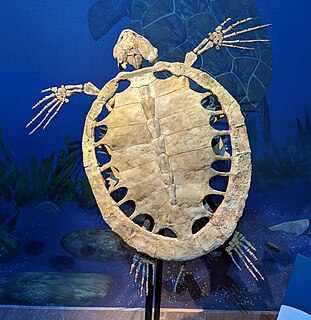
Euclastes is an extinct genus of sea turtles that survived the Cretaceous–Paleogene mass extinction. The genus was first named by Edward Drinker Cope in 1867, and contains three species. E. hutchisoni, was named in 2003 but has since been reassigned to the genus Pacifichelys, while E. coahuilaensis named in 2009 was reassigned as Mexichelys coahuilaensis in 2010.
Arabemys is an extinct genus of sea turtle. It was first named in 1999, and contains one species, A. crassiscutata. It is known from deposits of Late Paleocene or Early Eocene age near the village of Linah in northern Saudi Arabia.
Acherontemys is an extinct genus of turtle from Miocene of United States.

The Itaboraian age is a period within the Early Eocene geologic time epoch of the Paleogene, used more specifically with South American land mammal ages (SALMA). It follows the Riochican and precedes the Casamayoran age.
Cordichelys is an extinct genus of podocnemidid turtle. It was around during the Eocene. Fossils of this turtle have been discovered at Wadi El Hitan as of November 2020.
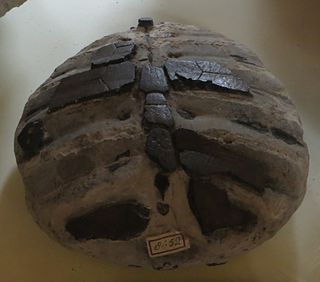
Puppigerus is an extinct genus of sea turtle from the Eocene. It is known from finds in the United States, the United Kingdom, Belgium, Denmark, and Uzbekistan.

Palaeoamyda is an extinct genus of softshell turtle belonging to the family Trionychidae. Remains have been found in the Eocene of Germany.

Echmatemys is an extinct genus of geoemydid turtle from the Eocene of North America. It is the oldest North American geoemydids, and is one of the most common early Eocene turtles.

The Fur Museum is a nationally recognized local natural history museum in Denmark. The museum is named after the Danish island Fur on which it is located. When the museum was founded in 1954, the focus was on the local history of the island. In 1957, the leader of Fur Museum found the fossil of a big leatherback turtle, and the focus of the museum shifted towards geology and natural history.
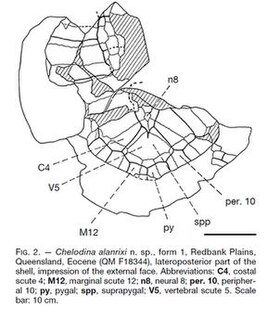
Chelodina alanrixi is a species of snake-necked fossil turtle which was described in 2001 using material gathered in Redbank Plains, Queensland, Australia. It is a member of the Chelidae Pleurodira. The fossil has been dated to the Eocene Epoch.

The Washakie Formation is a geologic formation in northern Colorado and southern Wyoming. It preserves many mammal, bird, reptile and other fossils dating back to the Lutetian stage of the Eocene within the Paleogene period. The sediments fall in the Bridgerian and Uintan stages of the NALMA classification.

Tasbacka is an extinct genus of sea turtle containing several species.
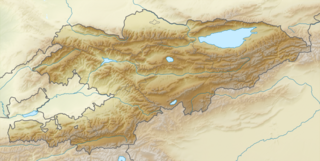
The Alai Beds is an Early Eocene geologic formation in the Osh Region of southwestern Kyrgyzstan. The formation has provided many fossils of mammals, lizards, turtles and snakes.

















